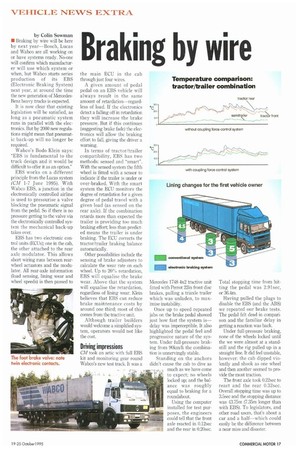Braking by wire
Page 19

If you've noticed an error in this article please click here to report it so we can fix it.
by Colin Sowman • Braking by wire will be here by next year—Bosch, Lucas and Wabco are all working on or have systems ready. No-one will confirm which manufacturer will use which system or when, but Wabco starts series production of its EBS (Electronic Braking System) next year, at around the time the new generation of MercedesBenz heavy trucks is expected.
It is now clear that existing legislation will be satisfied, as long as a pneumatic system runs in parallel with the electronics. But by 2000 new regulations might mean that pneumatic back-up will no longer be required.
Wabco's Bodo Klein says: "EBS is fundamental to the truck design and it would be difficult to offer it as an option."
EBS works on a different principle from the Lucas system (CM 1-7 June 1995). With Wabco EBS, a junction in the electronically controlled airline is used to pressurise a valve blocking the pneumatic signal from the pedal. So if there is no pressure getting to the valve via the electronically controlled system the mechanical back-up takes over.
EBS has two electronic control units (ECUs); one in the cab, the other attached to the rear axle modulator, This allows short wiring runs between rearwheel actuators and the modulator. All rear-axle information (load sensing, lining wear and wheel speeds) is then passed to the main ECU in the cab through just four wires.
A given amount of pedal pedal on an EBS vehicle will always result in the same amount of retardation—regardless of load. If the electronics detect a falling off in retardation they will increase the brake pressure. But if this continues (suggesting brake fade) the electronics will allow the braking effort to fall, giving the driver a warning.
In terms of tractor/trailer compatibility, EBS has two methods: sensed and "smart". With the sensed system the fifth wheel is fitted with a sensor to indicate if the trailer is under or over-braked. With the smart system the ECU monitors the degree of retardation for a given degree of pedal travel with a given load (as sensed on the rear axle). Tithe combination retards more than expected the trailer is providing too much braking effort; less than predicted means the trailer is under braking. The ECU corrects the tractor/trailer braking balance automatically.
Other possibilities include the sensing of brake adjusters to calculate the wear rate on each wheel. Up to 20% retardation, EBS will equalise the brake wear. Above that the system will equalise the retardation, regardless of lining wear. Klein believes that EBS can reduce brake maintenance costs by around one third; most of this comes from the tractive unit.
Although trailer builders would welcome a simplified system, operators would not like the cost
Driving impressions
CM took an attic with full EBS kit and monitoring gear round Wabco's new test track. It was a Mercedes 1748 4x2 tractive unit fitted with Perrot 22in front disc brakes, pulling a triaxle trailer which was unladen, to maximise instability.
Once up to speed repeated jabs on the brake pedal showed just how fast the system is— delay was imperceptible. It also highlighted the pedal feel and progressive nature of the system. Under full-pressure braking from 90km/h the combination is unnervingly stable.
Standing on the anchors didn't cause the cab to dive as much as we have come to expect; no wheels locked up; and the balance was roughly equal to braking for a roundabout.
Using the computer installed for test purposes, the engineers could tell that the front axle reacted in 0.12sec It! and the rear in 0.20sec. Total stopping time from hitting the pedal was 2.91sec, or 36.4m.
Having pulled the plugs to disable the EBS (and the ABS) we repeated our brake tests. The pedal felt dead in comparison and the familiar delay in getting a reaction was back.
Under full-pressure braking, none of the wheels locked until the we were almost at a standstill and the rig pulled up in a straight line. It did feel unstable, however: the cab dipped violently and shook as one wheel and then another seemed to provide the most traction.
The front axle took 022sec to react and the rear 0.32sec. Overall stopping time was up to 3.5-sec and the stopping distance was 43.75m (735m longer than with EBS). To legislators, and other road users, that's about a car and a half—which could easily be the difference between a near miss and disaster.




















































































































